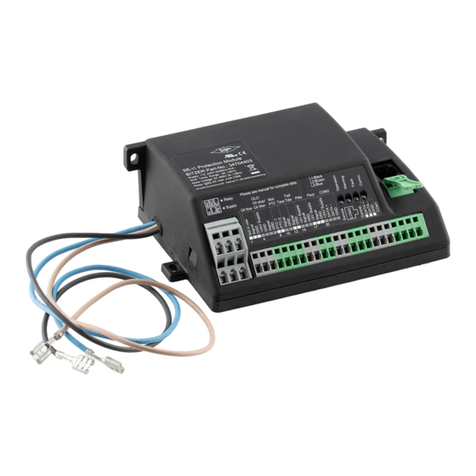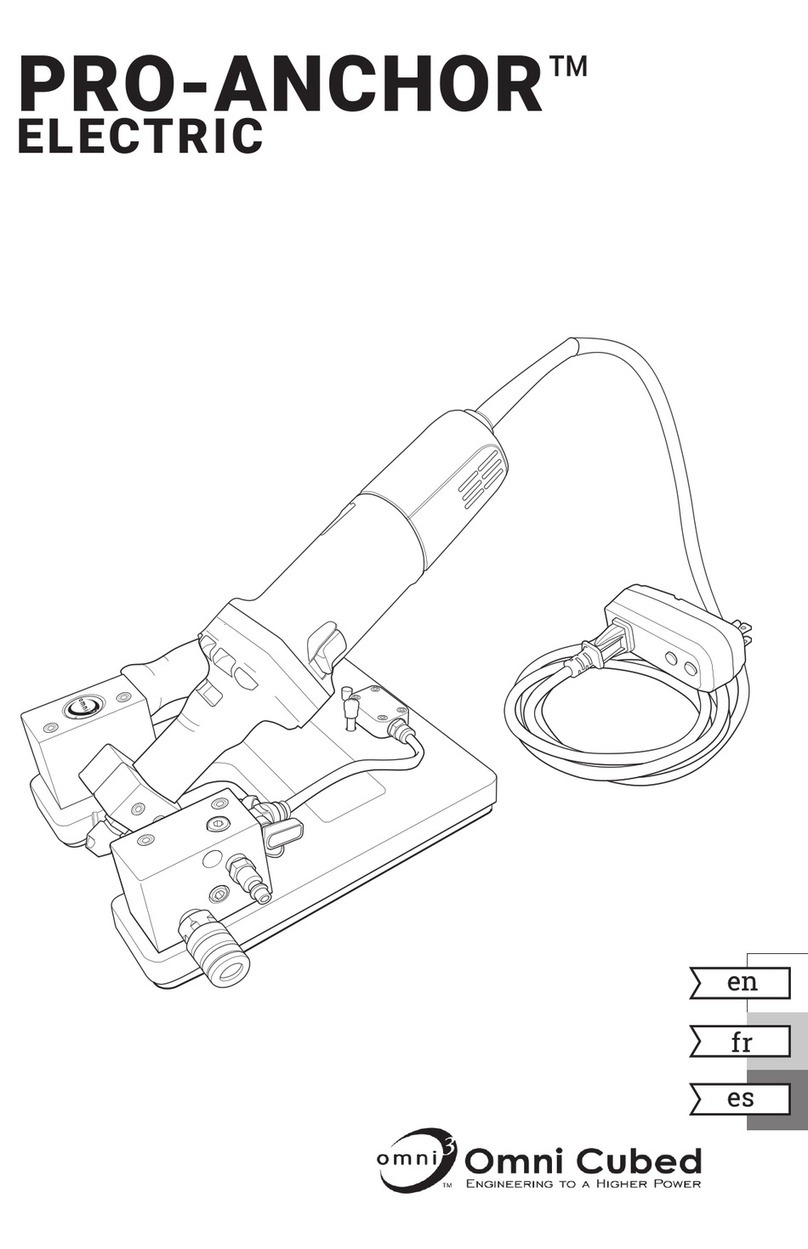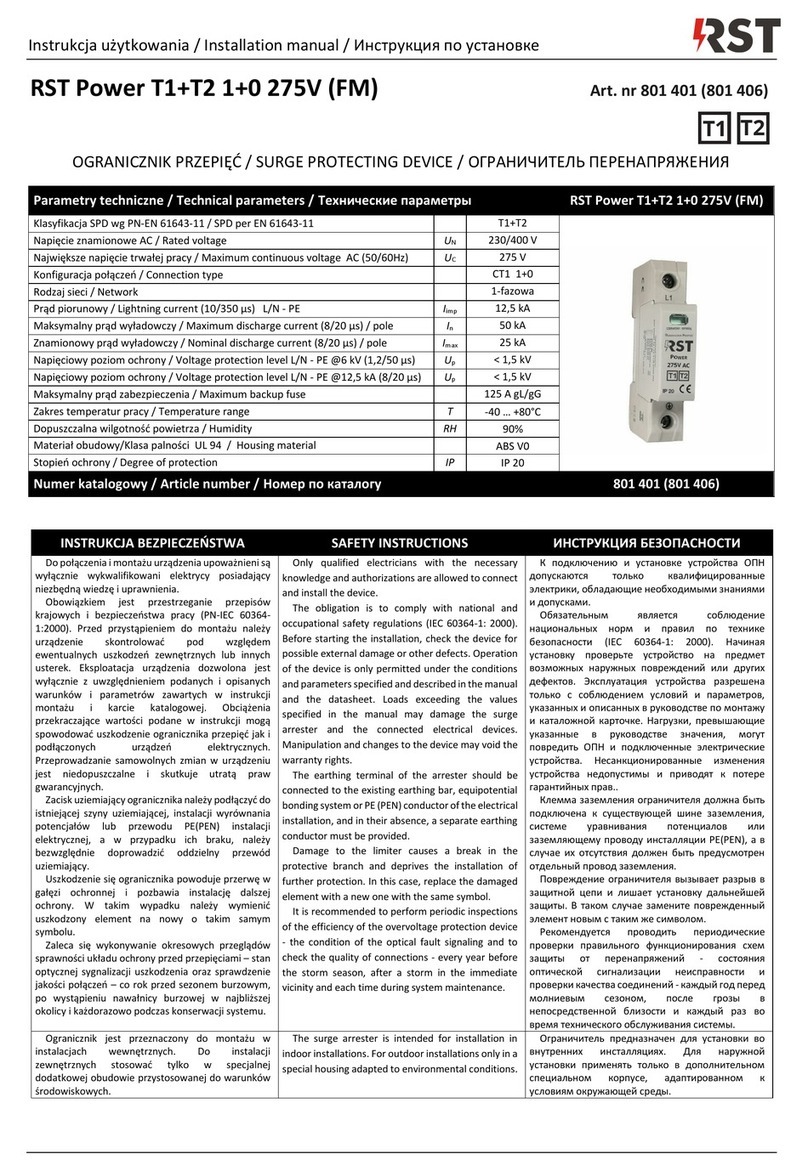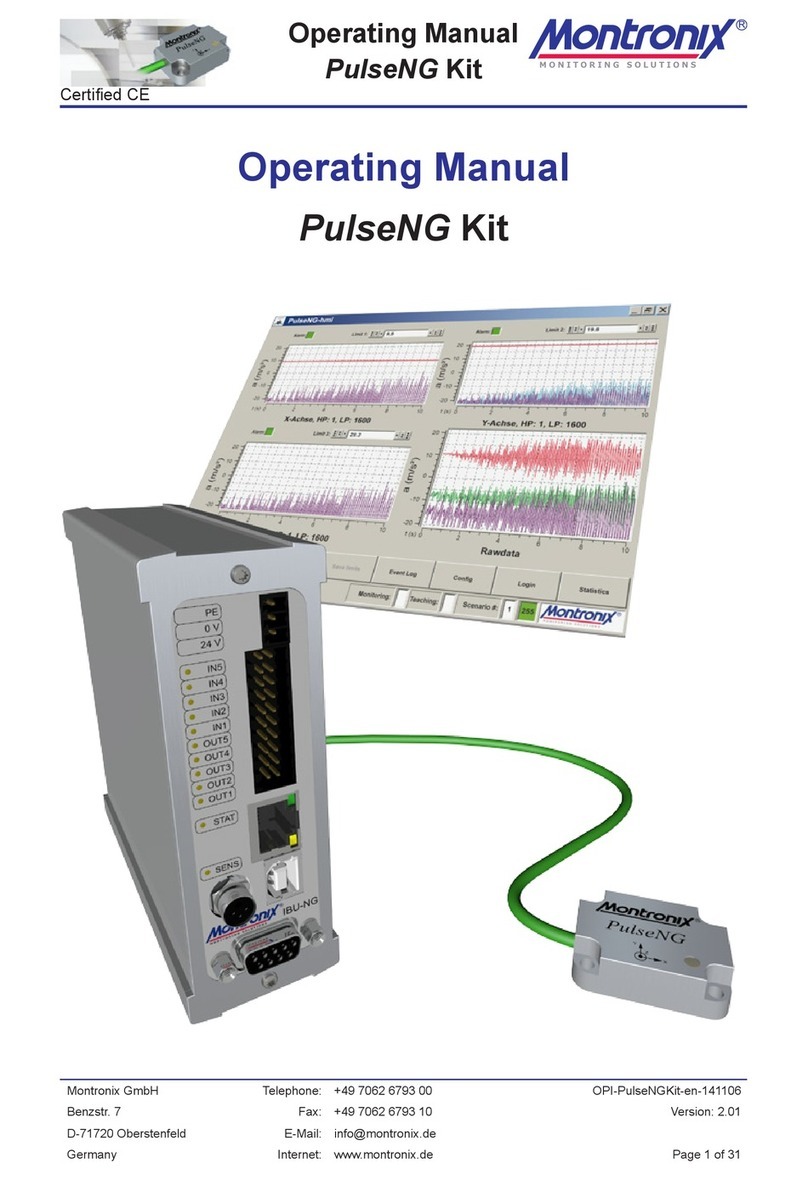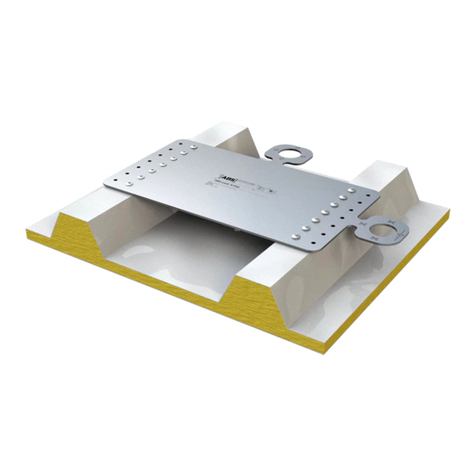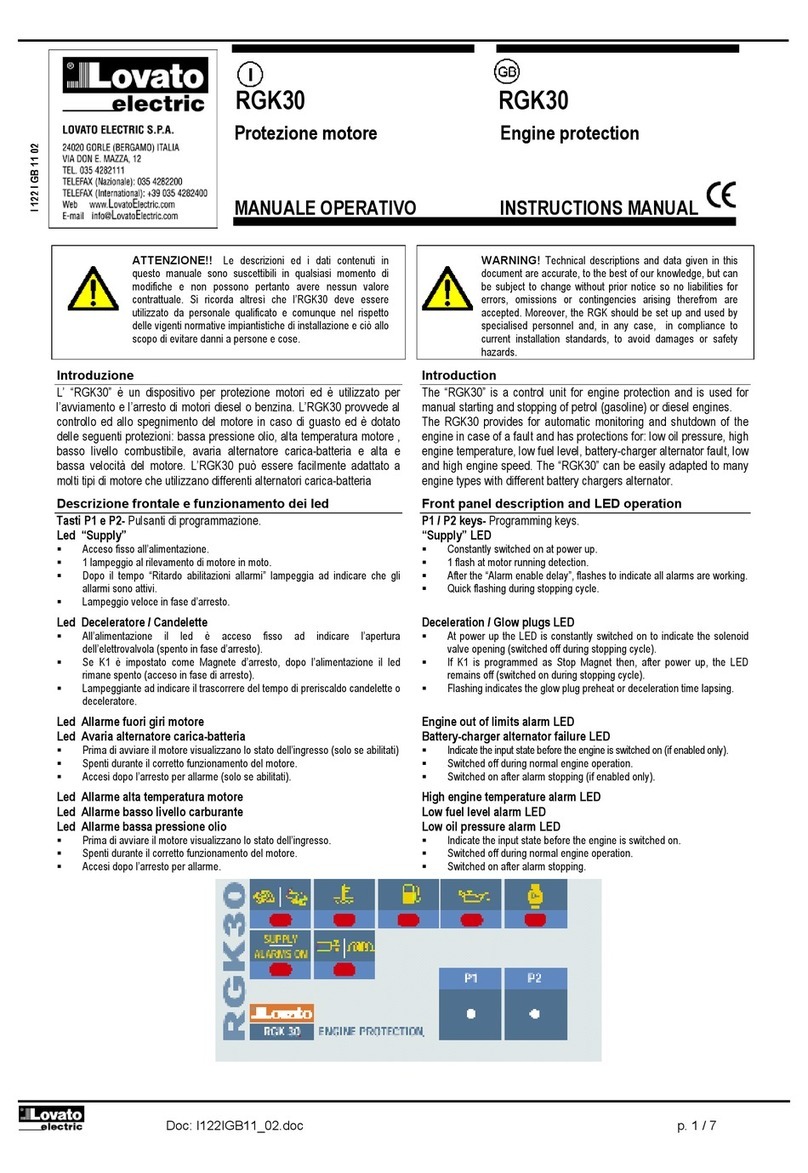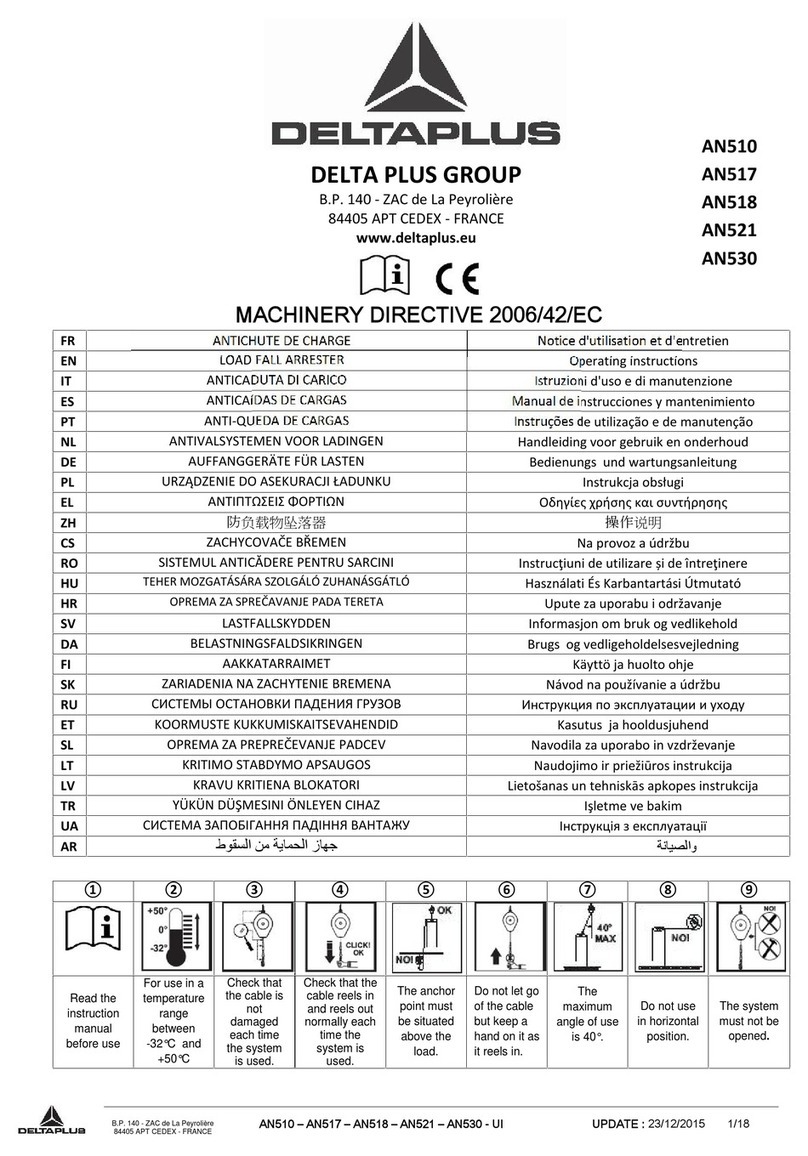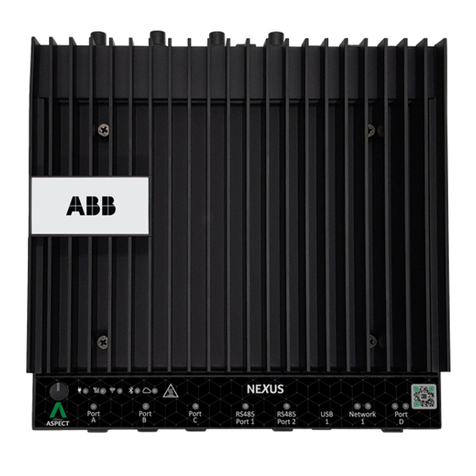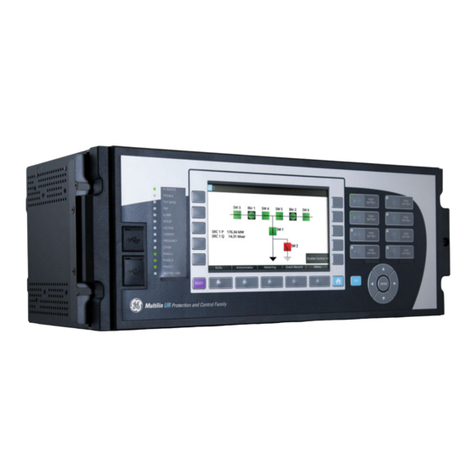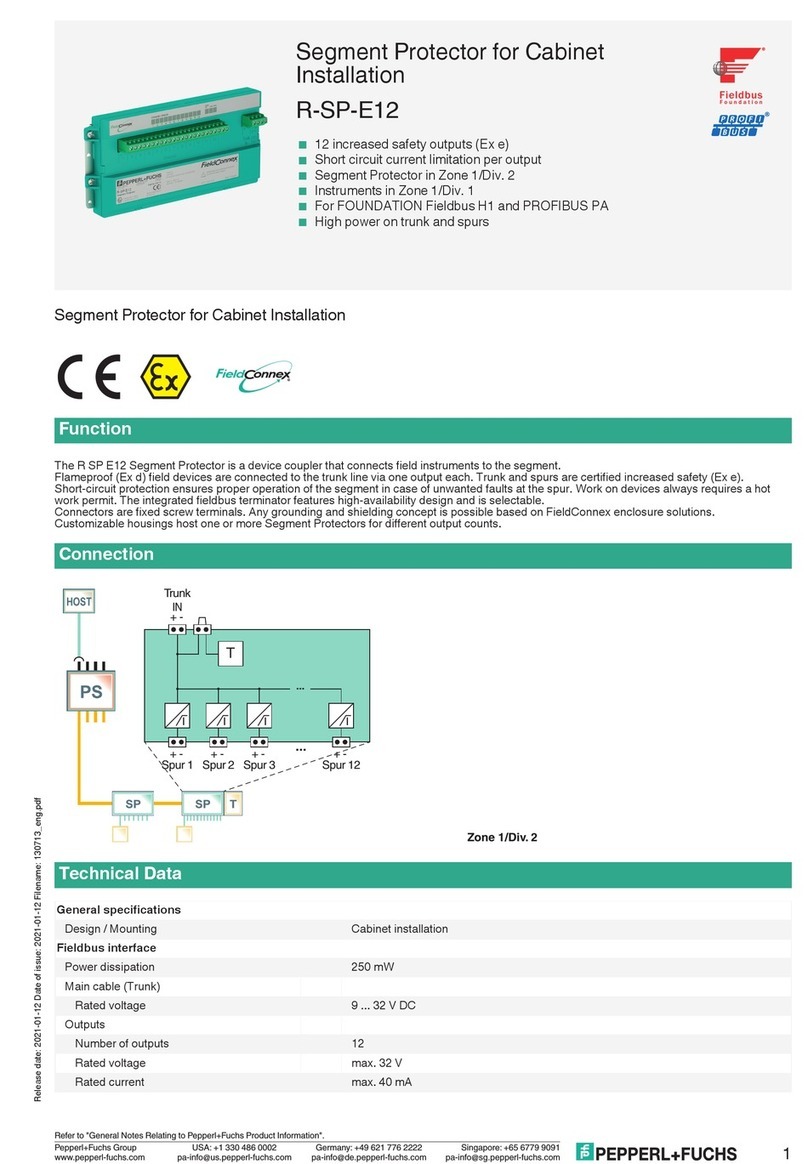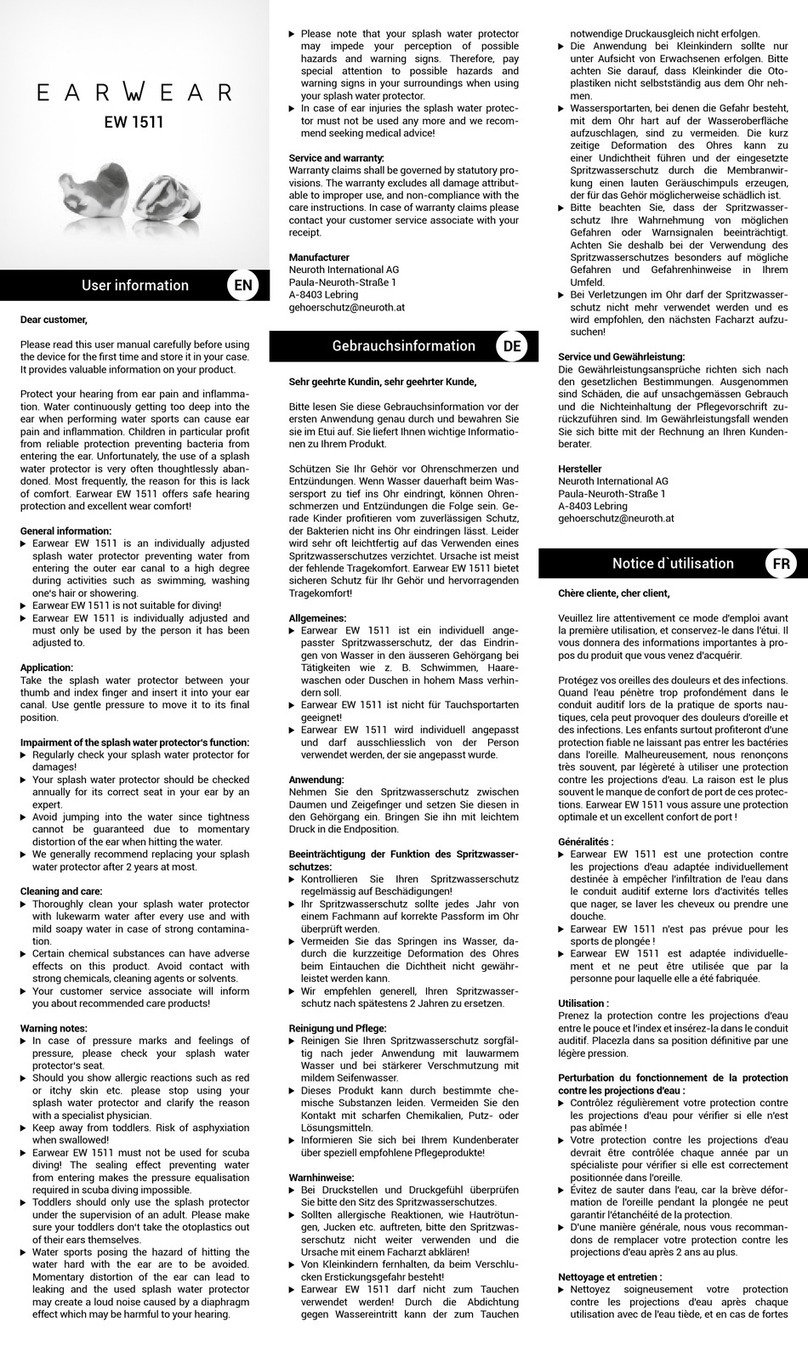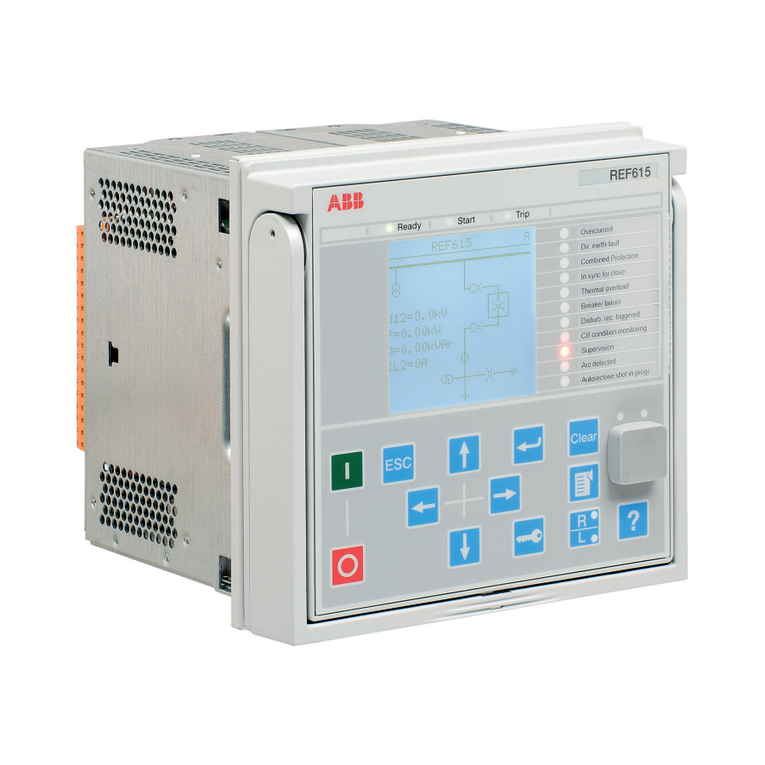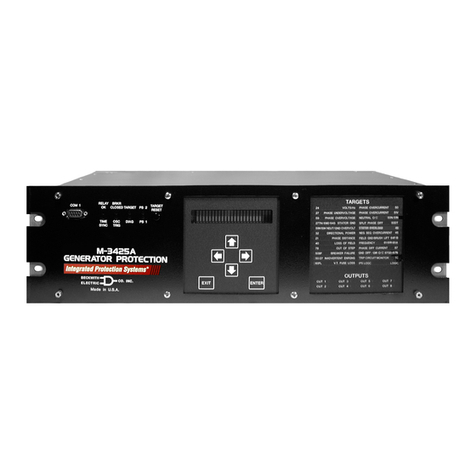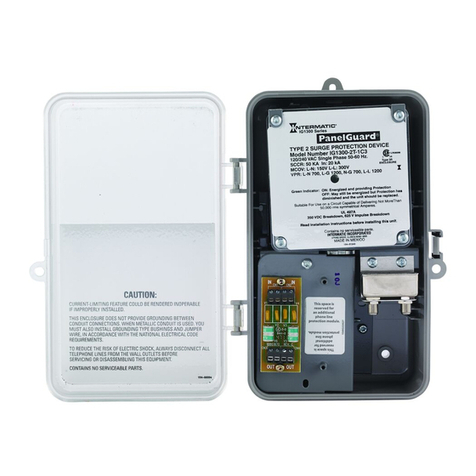Bitzer SE-E1 Manual

ST-120-3
Protection devices for screw compressors of HS.-, CS.-, OS.-, VSK series
Translation of the original document
English....................................................................................................................................................... 2
Schutzgeräte für Schraubenverdichter der HS.-, CS.-, OS.-, und VSK-Serie
Originaldokument
Deutsch ..................................................................................................................................................... 14
Dispositifs de protection pour des compresseurs à vis des séries HS.-, CS.-, OS.-, et VSK
Traduction du document original
Français..................................................................................................................................................... 25
SE-E1
SE-E3
SE-B2
OFC
Electrically skilled installer
Elektrisch unterwiesener Monteur
Monteur habilité

ST-120-32
Table of contents
1 Introduction............................................................................................................................................................3
2 Safety ....................................................................................................................................................................3
2.1 Authorized staff..............................................................................................................................................3
2.2 Residual risks ................................................................................................................................................3
2.3 Safety references...........................................................................................................................................3
2.3.1 General safety references.................................................................................................................. 4
3 Overview and technical data .................................................................................................................................5
3.1 Technical data ...............................................................................................................................................6
4 SE-E1 and SE-E3..................................................................................................................................................7
4.1 Monitoring functions SE-E1 and SE-E3.........................................................................................................7
5 SE-B2 ....................................................................................................................................................................8
5.1 Monitoring functions SE-B2 ...........................................................................................................................8
6 OFC .......................................................................................................................................................................8
7 Electrical connection..............................................................................................................................................9
7.1 Schematic wiring diagrams............................................................................................................................9
7.1.1 CS series: Connection of the protection devices SE-E1 / SE-E3 .................................................... 10
7.1.2 HS.53 .. HS.74: Connection of the protection devices SE-E1 / SE-E3 with SE-B2 ......................... 10
7.1.3 HS.53 .. HS.74: Connection of the protection devices SE-E1 / SE-E3 with OFC............................ 11
7.1.4 HS.85: Connection of the protection devices SE-E1 / SE-E3 with two SE-B2................................. 12
7.1.5 HS.85: Connection of the protection devices SE-E1 / SE-E3 with two SE-B2 and one OFC.......... 13

ST-120-3 3
1 Introduction
Electronic protection devices monitor the principal oper-
ating parameters and protect the compressor and the
system against abnormal operating conditions. The
protection devices SE-E* monitor the motor and dis-
charge gas temperature, rotation direction and phase
failure.
In addition to these functions, the SE-i1 monitors also
the cycling rate and the oil supply (oil level and oil flow).
During operation, numerous operating data of the com-
pressor can be tracked and evaluated via the integ-
rated interface using the BEST Software, for example,
the position in the application limits diagram. The data
are recorded and allow a specific diagnosis and optim-
ization of the compressor and system operation. For
further details, see Technical Information CT-110.
The protection devices OFC and SE-B2 are intended
for integration in the switch cabinet. They are used to
monitor the oil supply.
Only the protection devices SE-E2 and SE-i1 are
authorized for use with frequency inverters (FI).
This Technical Information provides an overview of all
BITZER protection devices for HS.-, CS.-, OS.- and
VSK screw compressors and a detailed description of
the following protection devices:
• SE-E1
• SE-E3
• SE-B2
• OFC
SE-B2 and OFC are used to monitor the oil circuit for
HS.- and OS.- screw compressors in connection with
the protection devices SE-E* (see chapter SE-B2, page
8 and see chapter OFC, page 8).
For the following protection devices, a separate Tech-
nical Information is available:
• SE-E2: Technical Information ST-122
•SE-i1: Technical Information CT-110
2 Safety
2.1 Authorized staff
All work done on the protection devices, compressors
and refrigeration systems may only be performed by
qualified and authorized staff who have been trained
and instructed accordingly. The local regulations and
guidelines will apply with respect to the qualification
and expertise of the specialists.
The protection devices have been built in accordance
with state-of-the-art methods and current regulations.
Particular importance was placed on user safety.
This Technical Information must be kept available near
the refrigeration system during the whole lifetime of the
protection device.
2.2 Residual risks
Compressors and electronic accessories may present
unavoidable residual risks. This is why any person
working on this device must carefully read this docu-
ment!
The following regulations shall apply:
• the relevant safety regulations and standards (e.g.
EN378, EN60204 and EN60335),
• generally accepted safety rules,
• EU directives,
• national regulations.
2.3 Safety references
are instructions intended to prevent hazards. Safety ref-
erences must be stringently observed!
!
!
NOTICE
Instructions on preventing possible damage to
equipment.
CAUTION
Instructions on preventing a possible minor haz-
ard to persons.
WARNING
Instructions on preventing a possible severe
hazard to persons.
DANGER
Instructions on preventing an immediate risk of
severe hazard to persons.

ST-120-34
2.3.1 General safety references
WARNING
Risk of electric shock!
Before performing any work in the terminal box
of the compressor: Switch off the main switch
and secure it against being switched on again!
Close the terminal box of the compressor before
switching on again!
!
!
NOTICE
Potential failure of the protection device and the
motor due to improper connection and/or faulty
operation!
Connect properly according to the schematic
wiring diagrams and check the connections for
tight seat.
The cables and terminals of the PTC control cir-
cuit must not come into contact with the control
voltage or operating voltage!
For work on the compressor once it has been put into
operation
CAUTION
Surface temperatures of more than 60°C or be-
low 0°C.
Risk of burns or frostbite.
Close off accessible areas and mark them.
Before performing any work on the compressor:
switch it off and let it cool down.

ST-120-3 5
3 Overview and technical data
The following table shows the product range of the
standard protection devices for BITZER screw com-
pressors and provides a short summary of the monitor-
ing functions. Each protection device is assigned to a
compressor series in which it can be used.
Protec-
tion
device
for com-
pressors
PTC con-
trol circuit
Monitoring of Fixation
Rotation
direction
Phase fail-
ure
Phase sym-
metry
Oil man-
agement
Cyc-
ling
rate
SE-E1 HS.
CSH,
CSW
① ①
5s / start
①: 3x
within
18min
①: 10x
within 24h
--- --- --- ③ / ④
SE-E2 VSK ①: 3x
within 2h
②
①
6s / start
①: 4x
within 2h
①: 11x
within 24h
②
①: 4x
within 2h
①: 11x
within 24h
②
--- --- ③ / ④
SE-E3 HS.
CSH,
CSW
① ①
5s / start
①: 3x
within
18min
①: 10x
within 24h
--- --- --- ③ / ④
SE-B2 HS.
OS.
--- --- --- --- ①
+K1T and
C1
--- ③ / ④
OFC HS.
OS.
--- --- --- --- ① --- ③
SE-i1 HS.53 ..
HS.85
CS.65..
CS.95
✔
⑥
✔
⑥
✔
⑥
--- ✔
⑥
✔
⑥
③
Tab.1: Overview of protection devices for screw compressors
K1T Time relay for oil flow monitoring C1: Electrolytic capacitor
Tab.2: Legend
① The protection device locks immediately when the
respective limit value is exceeded.
② The protection device switches the compressor im-
mediately off when the respective limit value is ex-
ceeded and switches the compressor automatically on
when the nominal temperature is reached or, in the
case of phase monitoring, after 10min.
③ Can be fixed with screws.
④ Can be fitted on a top hat rail.
⑤ The protection device limits the time period between
two compressor starts to at least 12 minutes (sum of
running time and shut-off period) or to a shut-off period
of at least 3minutes after a longer operation time.
⑥ Further information on the complete functional range
of the SE-i1 and on data communication using BEST,
see Technical Information CT-110.

ST-120-36
3.1 Technical data
Protection devices
SE-E1 SE-E2 SE-E3 SE-i1 SE-B2 OFC
Operating voltage 115 / 230V
+10/-15%
24..240V
+10/-25%
115 / 230V
+10/-15%
115..230
+10/-15%
230V
+10/-15%
230V
±10%
Operating fre-
quency
50/60HzAC 50/60Hz
AC/DC
50/60HzAC 50/60 HzAC 50/60HzAC 50/60HzAC
Motor voltage 200..600V
±10%
80..575V
±10%
600..690V
±10%
200..690V
±10%
--- ---
Motor frequency
range
50/60HzAC 20..100Hz
AC
50/60HzAC 20..135Hz
AC
--- ---
Relay:
• Switching
voltage Uswitch
240VAC 240VAC
min. 100mV
①
240VAC 250VAC 240VAC 250VAC
• Continuous cur-
rent Icontinuous
max. 2.5A max. 2.5A
min. 0.5mA
①
max. 2.5A max. 2.5A max. 2.5A max. 5A
• Switching capa-
city Iswitch
300VA 300VA 300VA 300VA 300VA 300VA
Allowable ambient
temperature
-30°C..
+60°C
-30°C..
+70°C
-30°C..
+60°C
-30°C..
+60°C
-30°C..
+70°C
-20°C..
+60°C
Required fuse 4A quick
acting
4A quick
acting
4A quick
acting
4A quick
acting
4A quick
acting
4A quick
acting
Enclosure class ter-
minals
IP00 IP00 IP00 IP20 IP00 IP00
Suitable for opera-
tion with frequency
inverter
--- 80..575V
±10%
20..100Hz
AC ②
--- 83..690V
+10%
50/60 Hz AC
③
--- ---
UL homologation Yes --- --- is being pre-
pared
--- ---
Tab.3: Overview of the technical data of the protection devices for screw compressors (in the case of differing requirements/operating condi-
tions, consultation with BITZER is recommended)
①: The SE-E2 has a relay with gold contacts. After a
first operation at AC/DC>36V or >50mA,the min-
imum switching voltage is AC/DC>24V and the min-
imum continuous current is >20mA.
②: Suitable for operation with soft starter at a ramp
time shorter than 1s.
③: For operation with soft starter: 200..690VAC,
±10%, 50/60HzAC
EMC: All protection devices comply with the EU EMC
directives 2014/30/EU and 2004/108/EC.
Interference immunity:
EN61000-6-1:2007, Immunity for residential, commer-
cial and light-industrial environments.
EN61000-6-2:2005, Immunity for industrial environ-
ments.
Emitted interference:
EN61000-6-3:2007 +A1:2011, Emission standard for
residential, commercial and light-industrial environ-
ments.

ST-120-3 7
4 SE-E1 and SE-E3
SE-E1 and SE-E3 are protection devices for extended
voltage and frequency ranges as well as for additional
monitoring functions (Signal Evaluation - Enhanced).
The protection device SE-E3 has been developed for
the motor voltage range of 600V..690V/3/50
and60Hz.
• Are used for:
– CSH and CSW series. Connection, see chapter
Schematic wiring diagrams, page 9.
– HS.53 series. Connection, see chapter Schematic
wiring diagrams, page 9.
– HS.85 series. Connection, see chapter Schematic
wiring diagrams, page 9.
• Fixation options:
– Can be fitted on a top hat rail.
– Can be fixed with screws.
• PTC control circuit:
Sensor type:
– Thermistors according to DIN44081/82
Thermistor type:
1..9 in series R25 total < 1.8kΩ
Break point:
Relay off >11.4kΩ±20%
Relay on >2.95kΩ±20%
Electrical and technical data, see table 3, page 6.
4.1 Monitoring functions SE-E1 and SE-E3
Connect the SE-E1 and SE-E3 in accordance with the
schematic wiring diagrams, see chapter Schematic wir-
ing diagrams, page 9.
!
!
NOTICE
Potential failure of the compressor protection
device and the motor due to improper connec-
tion and/or faulty operation!
The terminals M1-M2 or T1-T2 on the com-
pressor and 1-2 on the protection device must
not come into contact with the control voltage or
operating voltage!
Temperature monitoring
SE-E1 and SE-E3 lock immediately when the preset
motor, discharge gas or oil temperatures are exceeded.
The respective PTC temperature sensors must be con-
nected in series.
Rotation direction monitoring
SE-E1 and SE-E3 monitor the rotation direction within
the first 5seconds after the compressor start (operation
recognition). If the compressor starts with the wrong ro-
tation direction, SE-E1 and SE-E3 lock immediately.
Phase failure monitoring
In the event of a phase failure within the first 5 seconds
after the compressor start, SE-E1 and SE-E3 interrupt
immediately the relay contact in the safety chain and
close it again after 6 minutes. Moreover, SE-E1 and
SE-E3 lock after:
• 3 phase failures within 18 minutes and
• 10 phase failures within 24 hours.
Locked / reset
SE-E1 and SE-E3 locked: The safety chain (11/14) is
interrupted, the lamp H1 is lit (signal contact 12) and in-
dicates the fault.
To reset: Interrupt the voltage supply for at least 5
seconds. Let the compressor cool down and reset it
manually.

ST-120-38
5 SE-B2
5.1 Monitoring functions SE-B2
The SE-B2 is used for semi-hermetic and open drive
screw compressors in combination with a time relay
and an electrolytic capacitor for oil flow monitoring (Sig-
nal Evaluation – Basic). It is intended for installation in
a switch cabinet.
• Fixation:
– can be fitted on a top hat rail.
Connecting the oil flow monitoring
Connect the SE-B2 in accordance with the schematic
wiring diagram, see chapter Schematic wiring dia-
grams, page 9.
!
!
NOTICE
Potential failure of the compressor protection
device and the motor due to improper connec-
tion and/or faulty operation!
The terminals M1-M2 or T1-T2 on the com-
pressor and B1-B2 on the protection device as
well as its two orange cables must not come
into contact with the control voltage or operating
voltage!
Determine the polarity (+ / -) of the orange instrument
leads of the SE-B2 using a voltmeter and connect the
electrolytic capacitor with correct polarity.
Technical data, see table 3, page 6.
Locked / reset
SE-B2 locked: The safety chain (11/14) is interrupted,
the lamp H1 is lit (signal contact 12) and indicates the
fault.
To reset, interrupt the voltage supply for at least 5
seconds. Let the compressor cool down and reset it
manually.
6 OFC
As an alternative to the SE-B2, the OFC can also mon-
itor the oil flow (Oil Flow Control). The time relay (K1T)
and electrolytic capacitor (C1) are not required for this.
The OFC is intended for installation in the switch cab-
inet.
The OFC locks after the interruption of the oil flow
switch (F7) and the end of the bridging time.
• Fixation:
– can be fixed with screws.
• Control delay:
– 15..20 s during start procedure
– 2..3s during operation
Connecting the oil flow monitoring
Connect the OFC in accordance with the schematic
wiring diagrams, see chapter Schematic wiring dia-
grams, page 9.
!
!
NOTICE
Potential failure of the OFC due to improper
connection and/or faulty operation!
Never apply any external voltage to the sensor
inputs T11 and T12 – not even for test pur-
poses!
Technical data, see table 3, page 6.
Locked / reset
OFC locked: The safety chain (M1/M2) is interrupted.
Display via signaling contacts A1/A2, lamp H1 is lit and
indicates the fault.
To reset, interrupt the voltage supply for at least 5
seconds. Let the compressor cool down and reset it
manually.
Dimensional drawing OFC
108
120
50
80
Ø 4,2 55
Fig.1: Dimensional drawing OFC

ST-120-3 9
7 Electrical connection
7.1 Schematic wiring diagrams
The schematic wiring diagrams show the electrical con-
nection of the protection devices in the terminal box of
the compressor or in the switch cabinet of the system.
Detailed schematic wiring diagrams can be found in the
corresponding applications manual:
• SH-100: HS.53..HS.74
• SH-110: HS.85
• SH-500: OS.53 and OS.74
• SH-500: OS.85
Legend for schematic wiring diagram
C1 Electrolytic capacitor
F7 Oil flow switch
F9 Monitoring oil stop valve
F10 Oil filter monitoring
K1T Time relay "Oil supply monitoring" 20s
R1 Oil heater
R2 Discharge gas and oil temperature sensor
Permanently wired
Wired on site
Open drive screw compressors
For OS.53 to OS.85, the following protection devices
must be monitored in the same way as the respective
semi-hermetic compressor:
• The oil flow switch (F7) for OS.53 and OS.74.
• The oil flow switch (F7) and the oil stop valve (F9)
and the oil filter (F10) for OS.85.

ST-120-310
7.1.1 CS series: Connection of the protection devices
SE-E1 / SE-E3
R1
Ölheizung
Oil heater
Chauffage d'huile
7
T1
1
T2
SL
R2
5
11
12
Öltemperatur ühler (PTC)f
Oil temperature sensor (PTC)
Sonde température d'huile (CTP)
2
3
8
9
schwarz/black/noir
braun/brown/marron
blau/blue/bleu
N
114 11
12
L2
SE-E1 /
SE-E3
Anschlusskasten / Terminal box / Boîte de raccordement
Fig.2: CSH and CSW screw compressors: Example showing the connection of the protection devices SE-E1 / SE-E3
Legend see chapter Schematic wiring diagrams, page
9.
7.1.2 HS.53 .. HS.74: Connection of the protection
devices SE-E1 / SE-E3 with SE-B2
1
2
3
4
5
R2
F7
K1T
C1
+
SE-B2
N
B1
14
11
12
L
B2
7
T1
1
T2
SL
2
3
8
9
Anschlusskasten / Terminal box / Boîte de raccordement Schaltschrank / Switch / Armoire électriquecabinet
schwarz/black/noir
braun/brown/
marron
blau/blue/bleu
N
114 11
12
L2
SE-E1 /
SE-E3
Fig.3: HS.53 .. HS.74 screw compressors: Example showing the connection of SE-E1 / SE-E3 in the terminal box and SE-B2 in the switch cab-
inet
Legend see chapter Schematic wiring diagrams, page
9.

ST-120-3 11
7.1.3 HS.53 .. HS.74: Connection of the protection
devices SE-E1 / SE-E3 with OFC
1
2
3
4
5
R2
F7
7
T1
1
T2
SL
2
3
8
9
Anschlusskasten / Terminal box / Boîte de raccordement
Schaltschrank / Switch / Armoire électriquecabinet
schwarz/black/noir
braun/brown/
marron
blau/blue/bleu
N
114 11
12
L2
SE-E1 /
SE-E3
OFC
2
1
Fig.4: HS.53 .. HS.74 screw compressors: Example showing the connection of SE-E1 / SE-E3 in the terminal box and OFC in the switch cab-
inet
Legend see chapter Schematic wiring diagrams, page
9.

ST-120-312
7.1.4 HS.85: Connection of the protection devices
SE-E1 / SE-E3 with two SE-B2
R2
K1T
C1
+
K6T
F9 F10
p p
7
T1
1
T2
SL
2
3
8
9
Anschlusskasten / Terminal box / Boîte de raccordement Schaltschrank / Switch / Armoire électriquecabinet
schwarz/black/noir
braun/brown/
marron
blau/blue/bleu
N
114 11
12
L2
SE-E1 /
SE-E3
F7
7
8
6
5
4
2
1
3
SE-B2
N
B1
14
11
12
L
B2
SE-B2
N
B1
14
11
12
L
B2
Fig.5: HS.85 screw compressor: Example showing the connection of SE-E1 / SE-E3 in the terminal box and two SE-B2 in the switch cabinet
Legend see chapter Schematic wiring diagrams, page
9.

ST-120-3 13
7.1.5 HS.85: Connection of the protection devices
SE-E1 / SE-E3 with two SE-B2 and one OFC
OFC
2
1
R2
K6T
F9 F10
p p
7
T1
1
T2
SL
2
3
8
9
Anschlusskasten / Terminal box / Boîte de raccordement Schaltschrank / Switch / Armoire électriquecabinet
schwarz/black/noir
braun/brown/
marron
blau/blue/bleu
N
114 11
12
L2
SE-E1 /
SE-E3
F7
7
8
6
5
4
2
1
3
SE-B2
N
B1
14
11
12
L
B2
SE-B2
N
B1
14
11
12
L
B2
9
Fig.6: HS.85 screw compressor: Example showing the connection of SE-E1 / SE-E3 in the terminal box and two SE-B2 and one OFC in the
switch cabinet
Legend see chapter Schematic wiring diagrams, page
9.

ST-120-314
Inhaltsverzeichnis
1 Einleitung.............................................................................................................................................................15
2 Sicherheit.............................................................................................................................................................15
2.1 Autorisiertes Fachpersonal ..........................................................................................................................15
2.2 Restgefahren ...............................................................................................................................................15
2.3 Sicherheitshinweise.....................................................................................................................................15
2.3.1 Allgemeine Sicherheitshinweise ...................................................................................................... 16
3 Übersicht und Technische Daten ........................................................................................................................17
3.1 Technische Daten........................................................................................................................................18
4 SE-E1 und SE-E3................................................................................................................................................19
4.1 Überwachungsfunktionen SE-E1 und SE-E3 ..............................................................................................19
5 SE-B2 ..................................................................................................................................................................19
5.1 Überwachungsfunktionen SE-B2.................................................................................................................19
6 OFC .....................................................................................................................................................................20
7 Elektrischer Anschluss ........................................................................................................................................20
7.1 Prinzipschaltbilder........................................................................................................................................20
7.1.1 CS-Serie: Anschluss der Schutzgeräte SE-E1 / SE-E3................................................................... 21
7.1.2 HS.53 .. HS.74: Anschluss der Schutzgeräte SE-E1 / SE-E3 mit SE-B2 ........................................ 21
7.1.3 HS.53 .. HS.74: Anschluss der Schutzgeräte SE-E1 / SE-E3 mit OFC........................................... 22
7.1.4 HS.85: Anschluss der Schutzgeräte SE-E1 / SE-E3 mit zwei SE-B2.............................................. 23
7.1.5 HS.85: Anschluss der Schutzgeräte SE-E1 / SE-E3 mit zwei SE-B2 und einem OFC.................... 24

ST-120-3 15
1 Einleitung
Elektronische Schutzgeräte überwachen die wesentli-
chen Betriebsparameter und schützen so Verdichter
und Anlage vor abnormalen Betriebszuständen. Die
Schutzgeräte SE-E* überwachen Motor- und Druckga-
stemperatur, Drehrichtung und Phasenausfall.
Zusätzlich zu diesen Funktionen überwacht das SE-i1
noch Schalthäufigkeit und die Ölversorgung (Ölniveau
oder Ölfluss).
Beim SE-i1 können zudem zahlreiche Betriebsdaten
des Verdichters über die integrierte Schnittstelle mit der
BEST Software während des Betriebs verfolgt und aus-
gewertet werden, beispielsweise die Position im Ein-
satzgrenzdiagramm. Die Daten werden aufgezeichnet
und erlauben so eine gezielte Diagnose und Optimie-
rung des Verdichter- und Anlagenbetriebs. Für weitere
Informationen dazu siehe Technische Information
CT-110.
Die Schutzgeräte OFC und SE-B2 sind für den Einbau
im Schaltschrank vorgesehen. Sie dienen zur Überwa-
chung der Ölversorgung.
Für den Einsatz mit Frequenzumrichter (FU) sind nur
die Schutzgerät SE-E2 und SE-i1 zugelassen.
Diese Technische Information gibt einen Überblick über
alle BITZER Schutzgeräte für HS.-, CS.-, OS.- und
VSK-Schraubenverdichter und geht detailierter auf fol-
gende Schutzgeräte ein:
• SE-E1
• SE-E3
• SE-B2
• OFC
SE-B2 und OFC dienen zur Überwachung des Ölkreis-
laufs bei HS.- und OS.-Schraubenverdichtern in Verbin-
dung mit den Schutzgeräten SE-E* (siehe Kapitel SE-
B2, Seite 19 und siehe Kapitel OFC, Seite 20).
Für folgende Schutzgeräte sind eigene Technische In-
formationen erhältlich:
• SE-E2: Technische Information ST-122
•SE-i1: Technische Information CT-110
2 Sicherheit
2.1 Autorisiertes Fachpersonal
Sämtliche Arbeiten an Schutzgeräten, Verdichtern und
Kälteanlagen dürfen nur von Fachpersonal ausgeführt
werden, das in allen Arbeiten ausgebildet und unterwie-
sen wurde. Für die Qualifikation und Sachkunde des
Fachpersonals gelten die jeweils landesüblichen Vor-
schriften und Richtlinien.
Die Schutzgeräte sind nach dem aktuellen Stand der
Technik und entsprechend den geltenden Vorschriften
gebaut. Auf die Sicherheit der Anwender wurde beson-
derer Wert gelegt.
Diese Technische Information während der gesamten
Lebensdauer des Schutzgeräts an der Kälteanlage ver-
fügbar halten.
2.2 Restgefahren
Von Verdichtern und elektronischem Zubehör können
unvermeidbare Restgefahren ausgehen. Jede Person,
die an diesem Gerät arbeitet, muss deshalb dieses Do-
kument sorgfältig lesen!
Es gelten zwingend
• die einschlägigen Sicherheitsvorschriften und Nor-
men (z.B. EN 378, EN 60204 und EN 60335),
• die allgemein anerkannten Sicherheitsregeln,
• die EU-Richtlinien,
• nationale Vorschriften.
2.3 Sicherheitshinweise
sind Anweisungen um Gefährdungen zu vermeiden. Si-
cherheitshinweise genauestens einhalten!
!
!
HINWEIS
Anweisungen um eine mögliche Gefährdung
von Geräten zu vermeiden.
VORSICHT
Anweisung um eine mögliche minderschwere
Gefährdung von Personen zu vermeiden.
WARNUNG
Anweisung um eine mögliche schwere Gefähr-
dung von Personen zu vermeiden.
GEFAHR
Anweisung um eine unmittelbare schwere Ge-
fährdung von Personen zu vermeiden.

ST-120-316
2.3.1 Allgemeine Sicherheitshinweise
WARNUNG
Gefahr von elektrischem Schlag!
Vor Arbeiten im Anschlusskasten des Verdich-
ters: Hauptschalter ausschalten und gegen Wie-
dereinschalten sichern!
Vor Wiedereinschalten Anschlusskasten des
Verdichters schließen!
!
!
HINWEIS
Ausfall des Schutzgeräts und des Motors durch
fehlerhaften Anschluss und/oder Fehlbedienung
möglich!
Anschlüsse gemäß Prinzipschaltbildern korrekt
ausführen und auf festen Sitz prüfen.
Kabel und Klemmen des PTC-Messkreises dür-
fen nicht mit Steuer- oder Betriebsspannung in
Berührung kommen!
Bei Arbeiten am Verdichter, nachdem er in Betrieb
genommen wurde
VORSICHT
Oberflächentemperaturen von über 60°C bzw.
unter 0°C.
Verbrennungen und Erfrierungen möglich.
Zugängliche Stellen absperren und kennzeich-
nen.
Vor Arbeiten am Verdichter: Ausschalten und
abkühlen lassen.

ST-120-3 17
3 Übersicht und Technische Daten
Die nachfolgende Tabelle zeigt das Produktspektrum
der Standardschutzgeräte für BITZER Schraubenver-
dichter und gibt eine kurze Zusammenfassung der
Überwachungsfunktionen. Jedem Schutzgerät ist zu-
dem die Verdichterserie zugeordnet, bei der es einge-
setzt werden kann.
Schutz-
gerät
für Ver-
dichter
PTC-
Mess-
kreis
Überwachung von Befesti-
gung
Drehrich-
tung
Phasenaus-
fall
Phasen-
asymmetrie
Ölmanage-
ment
Schalt-
häu-
figkeit
SE-E1 HS.
CSH,
CSW
① ①
5 s / Start
①: 3x in
18min
①: 10x in
24h
--- --- --- ③ / ④
SE-E2 VSK ①: 3x in
2h
②
①
6 s / Start
①: 4x in 2h
①: 11x in
24h
②
①: 4x in 2h
①: 11x in
24h
②
--- --- ③ / ④
SE-E3 HS.
CSH,
CSW
① ①
5 s / Start
①: 3x in
18min
①: 10x in
24h
--- --- --- ③ / ④
SE-B2 HS.
OS.
--- --- --- --- ①
+K1T und
C1
--- ③ / ④
OFC HS.
OS.
--- --- --- --- ① --- ③
SE-i1 HS.53 ..
HS.85
CS.65 ..
CS.95
✔
⑥
✔
⑥
✔
⑥
--- ✔
⑥
✔
⑥
③
Tab.1: Übersicht Schutzgeräte für Schraubenverdichter
K1T Zeitrelais zur Öldurchflussüberwachung C1: Elektrolytkondensator
Tab.2: Legende
① Schutzgerät verriegelt sofort, wenn der jeweilige
Grenzwert überschritten wird.
② Schutzgerät schaltet den Verdichter sofort ab, wenn
der jeweilige Grenzwert überschritten wird und schaltet
den Verdichter automatisch zu, wenn die Solltempera-
tur erreicht ist oder im Fall von Phasenüberwachung
nach 10 min.
③ Verschraubbar.
④ Einrastbar auf Hutschiene.
⑤ Schutzgerät begrenzt den Zeitraum zwischen zwei
Verdichteranläufen auf mindestens 12 Minuten (Sum-
me aus Lauf- und Stillstandszeit) bzw. auf mindestens
3Minuten Stillstandszeit nach längerer Betriebsphase.
⑥ Weitere Informationen zum vollen Funktionumfang
des SE-i1 und zur Datenkommunikation mit der BEST,
siehe Technische Information CT-110.

ST-120-318
3.1 Technische Daten
Schutzgeräte
SE-E1 SE-E2 SE-E3 SE-i1 SE-B2 OFC
Betriebsspannung 115 / 230V
+10/-15%
24 .. 240V
+10/-25%
115 / 230V
+10/-15%
115 .. 230
+10/-15%
230V
+10/-15%
230V
±10%
Betriebsfrequenz 50/60Hz∿ 50/60Hz ∿/= 50/60Hz∿ 50/60 Hz ∿ 50/60Hz∿ 50/60Hz∿
Motorspannung 200 .. 600V
±10%
80 .. 575V
±10%
600 .. 690V
±10%
200 .. 690 V
±10%
--- ---
Motorfrequenzbe-
reich
50/60Hz∿ 20 ..
100Hz∿
50/60Hz∿ 20 .. 135 Hz
∿
--- ---
Relais:
• Schaltspannung
USchalt
240V∿ 240V∿
min. 100mV
①
240V∿ 250V∿ 240V∿ 250V∿
• Dauerstrom IDauer max. 2,5A max. 2,5A
min. 0,5mA
①
max. 2,5A max. 2,5A max. 2,5A max. 5A
• Schaltleistung
ISchalt
300VA 300VA 300VA 300VA 300VA 300VA
Zulässige Umge-
bungstemperatur
-30°C ..
+60°C
-30°C ..
+70°C
-30°C ..
+60°C
-30°C ..
+60°C
-30°C ..
+70°C
-20°C ..
+60°C
Erforderliche Siche-
rung
4 A flink 4 A flink 4 A flink 4 A flink 4 A flink 4 A flink
Schutzart Klemmen IP00 IP00 IP00 IP20 IP00 IP00
Geeignet für Be-
trieb mit Frequen-
zumrichter
--- Ja
80 .. 575V
±10%
20 ..
100Hz∿ ②
--- 83 .. 690 V
+10%
50/60 Hz ∿
③
--- ---
UL-Freigabe Ja --- --- In Vorberei-
tung
--- ---
Tab.3: Übersicht Technische Daten der Schutzgeräte für Schraubenverdichter (bei abweichenden Anforderungen/Betriebsbedingungen empf-
hielt sich Rücksprache mit BITZER)
①: Das SE-E2 hat ein Relais mit Goldkontakten. Nach
einmaligem Betrieb ∿/=>36V oder >50mA,ist die mi-
nimale Schaltspannung ∿/=>24V und der minimale
Dauerstrom >20mA.
②: Geeignet für Betrieb mit Softstarter bei einer Ram-
penzeit kleiner 1 s.
③: Bei Betrieb mit Softstarter: 200 .. 690 V ∿, ±10%,
50/60 Hz ∿.
EMV: Alle Schutzgeräte entsprechen der EU-EMV-
Richtlinien 2014/30/EU und 2004/108/EG
Störfestigkeit:
EN61000-6-1:2007, Störfestigkeit für Wohnbereich,
Geschäfts- und Gewerbebereiche sowie Kleinbetriebe.
EN61000-6-2:2005, Störfestigkeit für Industrieberei-
che.
Störaussendung:
EN61000-6-3:2007 +A1:2011, Störaussendung für
Wohnbereich, Geschäfts- und Gewerbebereiche sowie
Kleinbetriebe.

ST-120-3 19
4 SE-E1 und SE-E3
SE-E1 und SE-E3 sind Schutzgeräte für erweiterte
Spannungs- und Frequenzbereiche sowie für zusätzli-
che Überwachungsfunktionen (Signal Evaluation – En-
hanced).
Das Schutzgerät SE-E3 wurde speziell für den Motor-
spannungsbereich 600 V .. 690 V / 3 / 50 und 60Hz
entwickelt.
• Werden eingesetzt bei:
– CSH- und CSW-Serie. Anschluss, siehe Kapitel
Prinzipschaltbilder, Seite 20.
– HS.53-Serie. Anschluss, siehe Kapitel Prinzip-
schaltbilder, Seite 20.
– HS.85-Serie. Anschluss, siehe Kapitel Prinzip-
schaltbilder, Seite 20.
• Befestigungsmöglichkeiten:
– Einrastbar auf Hutschiene.
– Verschraubbar.
• PTC-Messkreis:
Art der Fühler:
– Thermistoren nach DIN 44081/82
Art der Thermistoren:
1 .. 9 in Serie R25ges. < 1,8 kΩ
Schaltpunkt:
Relais aus > 11,4 kΩ ±20%
Relais ein < 2,95 kΩ ±20%
Elektrische und Technische Daten, siehe Tabelle 3,
Seite 18.
4.1 Überwachungsfunktionen SE-E1 und SE-E3
SE-E1 und SE-E3 entsprechend Prinzipschaltbildern
anschließen, siehe Kapitel Prinzipschaltbilder, Seite
20.
!
!
HINWEIS
Ausfall des Verdichterschutzgeräts und des Mo-
tors durch fehlerhaften Anschluss und/oder
Fehlbedienung möglich!
Klemmen M1-M2 oder T1-T2 am Verdichter und
1-2 am Schutzgerät dürfen nicht mit Steuer-
oder Betriebsspannung in Berührung kommen!
Temperaturüberwachung
SE-E1 und SE-E3 verriegeln sofort, wenn die voreinge-
stellten Motor-, Druckgas - oder Öltemperaturen über-
schritten werden. Die entsprechenden PTC-Tempera-
turfühler müssen elektrisch in Reihe angeschlossen
werden.
Drehrichtungsüberwachung
SE-E1 und SE-E3 überwachen die Drehrichtung inner-
halb der ersten 5 Sekunden nach Start des Verdichters
(Lauferkennung). Wenn der Verdichter mit falscher
Drehrichtung anläuft, verriegeln SE-E1 und SE-E3 so-
fort.
Phasenausfallüberwachung
Bei Phasenausfall innerhalb der ersten 5 Sekunden
nach Start des Verdichters unterbrechen SE-E1 und
SE-E3 sofort den Relaiskontakt in der Sicherheitskette
und schließen ihn nach 6 Minuten wieder. SE-E1 und
SE-E3 verriegeln zudem nach:
• 3 Phasenausfällen innerhalb von 18 Minuten und
• 10 Phasenausfällen innerhalb von 24 Stunden.
Verriegelt / entriegeln
SE-E1 und SE-E3 verriegelt: Die Sicherheitskette
(11/14) ist unterbrochen, die Lampe H1 leuchtet (Si-
gnalkontakt 12) und zeigt die Störung an.
Zum Entriegeln: Spannungsversorgung mindestens 5
Sekunden lang unterbrechen. Verdichter abkühlen las-
sen und manuell entriegeln.
5 SE-B2
5.1 Überwachungsfunktionen SE-B2
Das SE-B2 wird bei halbhermetischen und offenen
Schraubenverdichtern in Kombination mit einem Zeitre-
lais und Elektrolytkondensator zur Öldurchflussüberwa-
chung eingesetzt (Signal Evaluation – Basic). Es ist
zum Einbau in den Schaltschrank vorgesehen.
• Befestigung:
– kann auf Hutschiene eingerastet werden.
Öldurchflussüberwachung anschließen
Das SE-B2 entsprechend Prinzipschaltbild anschlie-
ßen, siehe Kapitel Prinzipschaltbilder, Seite 20.

ST-120-320
!
!
HINWEIS
Ausfall des Verdichterschutzgeräts und des Mo-
tors durch fehlerhaften Anschluss und/oder
Fehlbedienung möglich!
Klemmen M1-M2 oder T1-T2 am Verdichter und
B1-B2 am Schutzgerät sowie die beiden oran-
genen Kabel des Schutzgeräts dürfen nicht mit
Steuer- oder Betriebsspannung in Berührung
kommen!
Polung (+ / -) an orangenen Messleitungen des SE-B2
mit Spannungsmessgerät ermitteln und Elektrolytkon-
densator mit richtiger Polung anschließen.
Technische Daten, siehe Tabelle 3, Seite 18.
Verriegelt / entriegeln
SE-B2 verriegelt: Die Sicherheitskette (11/14) ist unter-
brochen, die Lampe H1 leuchtet (Signalkontakt 12) und
zeigt die Störung an.
Zum Entriegeln die Spannungsversorgung mindestens
5 Sekunden lang unterbrechen. Verdichter abkühlen
lassen und manuell entriegeln.
6 OFC
Alternativ zum SE-B2 kann auch das OFC den Öl-
durchfluss überwachen (Oil Flow Control). Zeitrelais
(K1T) und Elektrolytkondensator (C1) werden dabei
nicht benötigt. Das OFC ist zum Einbau in den Schalt-
schrank vorgesehen.
Das OFC verriegelt nach Unterbrechung des Öldurch-
flusswächters (F7) und Ablauf der Überbrückungszeit.
• Befestigung:
– kann verschraubt werden.
• Auslöseverzögerungszeit:
– 15 .. 20 s beim Start
– 2 .. 3 s im Betrieb
Öldurchflussüberwachung anschließen
OFC entsprechend Prinzipschaltbildern anschließen,
siehe Kapitel Prinzipschaltbilder, Seite 20.
!
!
HINWEIS
Ausfall des OFC durch fehlerhaften Anschluss
und/oder Fehlbedienung möglich!
An Sensoreingang T11 und T12 keine Fremd-
spannung anlegen, auch nicht zum Prüfen!
Technische Daten, siehe Tabelle 3, Seite 18.
Verriegelt / entriegeln
OFC verriegelt: Die Sicherheitskette (M1/M2) ist unter-
brochen. Anzeige über Signalkontakte A1/A2, Lampe
H1 leuchtet und zeigt die Störung an.
Zum Entriegeln die Spannungsversorgung mindestens
5 Sekunden lang unterbrechen. Verdichter abkühlen
lassen und manuell entriegeln.
Maßzeichnung OFC
108
120
50
80
Ø 4,2 55
Abb.1: Maßzeichnung OFC
7 Elektrischer Anschluss
7.1 Prinzipschaltbilder
Die Prinzipschaltbilder zeigen den elektrischen An-
schluss der Schutzgeräte im Anschlusskasten des Ver-
dichters oder Schaltschrank der Anlage. Detaillierte
Prinzipschaltbilder sind im jeweiligen Projektierungs-
handbuch zu finden:
• SH-100: HS.53 .. HS.74
• SH-110: HS.85
• SH-500: OS.53 und OS.74
• SH-500: OS.85
Legende Prinzipschaltbilder
C1 Elektrolytkondensator
F7 Öldurchflusswächter
F9 Überwachung Ölstoppventil
F10 Ölfilterüberwachung
K1T Zeitrelais "Überwachung der Ölversor-
gung" 20s
R1 Ölheizung
R2 Druckgas- und Öltemperaturfühler
Fest verdrahtet
Bauseitig verdrahtet
This manual suits for next models
3
Table of contents
Languages:
Other Bitzer Protection Device manuals
